Racial Disparity in Singapore Criminal Justice System: A Report
VerifiedAdded on 2022/08/12
|9
|2031
|22
Report
AI Summary
This report, prepared by university students, investigates the issue of disproportionate racial representation in Singapore's criminal and penal official statistics. The research reveals a close association between crimes and race, highlighting unequal treatment within the judicial system, particularly for Malays and Indians who are minorities, compared to the Chinese majority. The report examines how systemic biases and prejudices influence conviction rates, sentencing, and the overall portrayal of different racial groups in crime statistics. It delves into the historical and social factors contributing to these disparities, including the impact of socio-economic power dynamics and the application of criminological theories such as the critical race theory and cultural transmission theory. The report concludes that racial discrimination is a significant factor in the disparities observed in the criminal justice system and calls for a proper way of mitigation of racial discrimination.
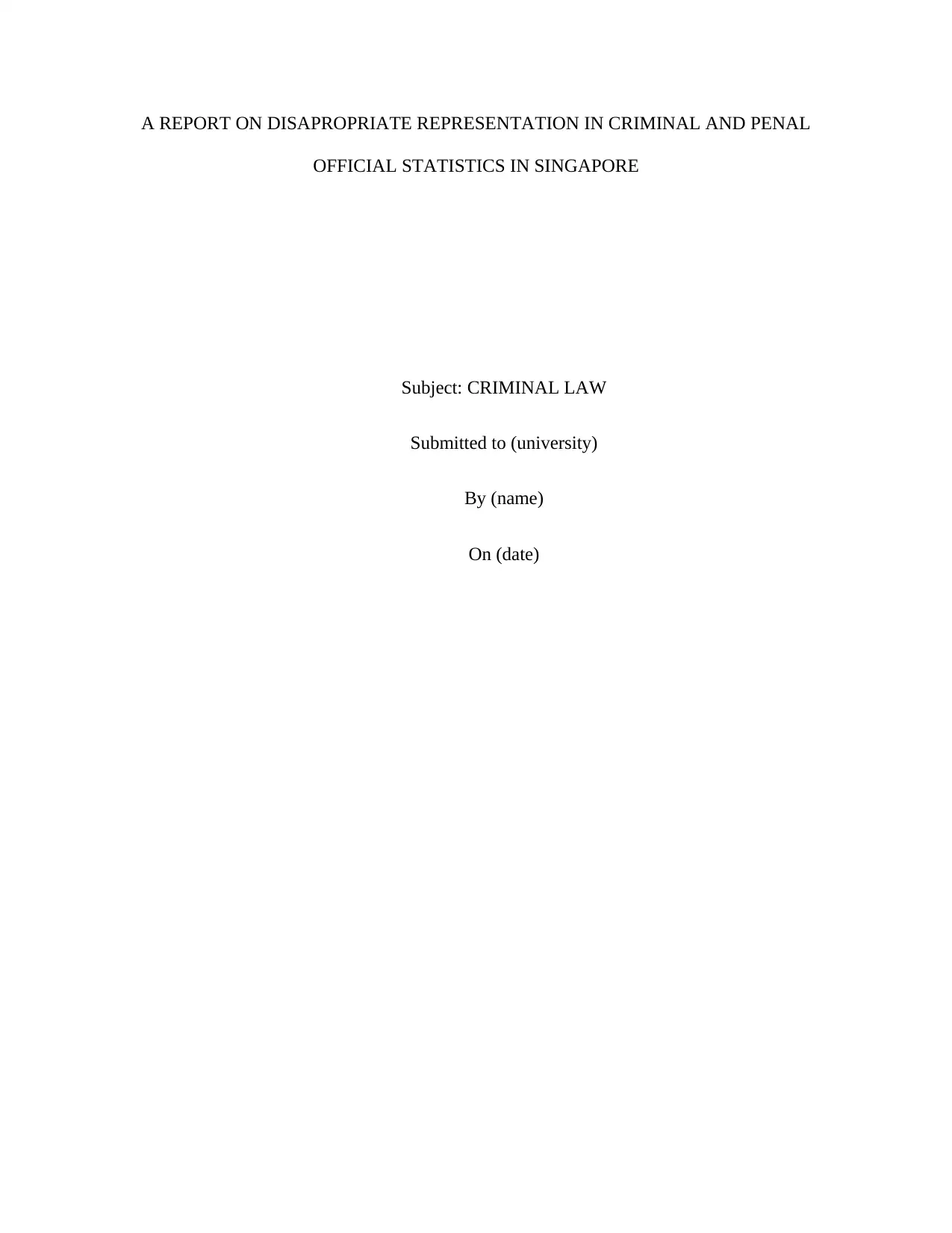
A REPORT ON DISAPROPRIATE REPRESENTATION IN CRIMINAL AND PENAL
OFFICIAL STATISTICS IN SINGAPORE
Subject: CRIMINAL LAW
Submitted to (university)
By (name)
On (date)
OFFICIAL STATISTICS IN SINGAPORE
Subject: CRIMINAL LAW
Submitted to (university)
By (name)
On (date)
Paraphrase This Document
Need a fresh take? Get an instant paraphrase of this document with our AI Paraphraser
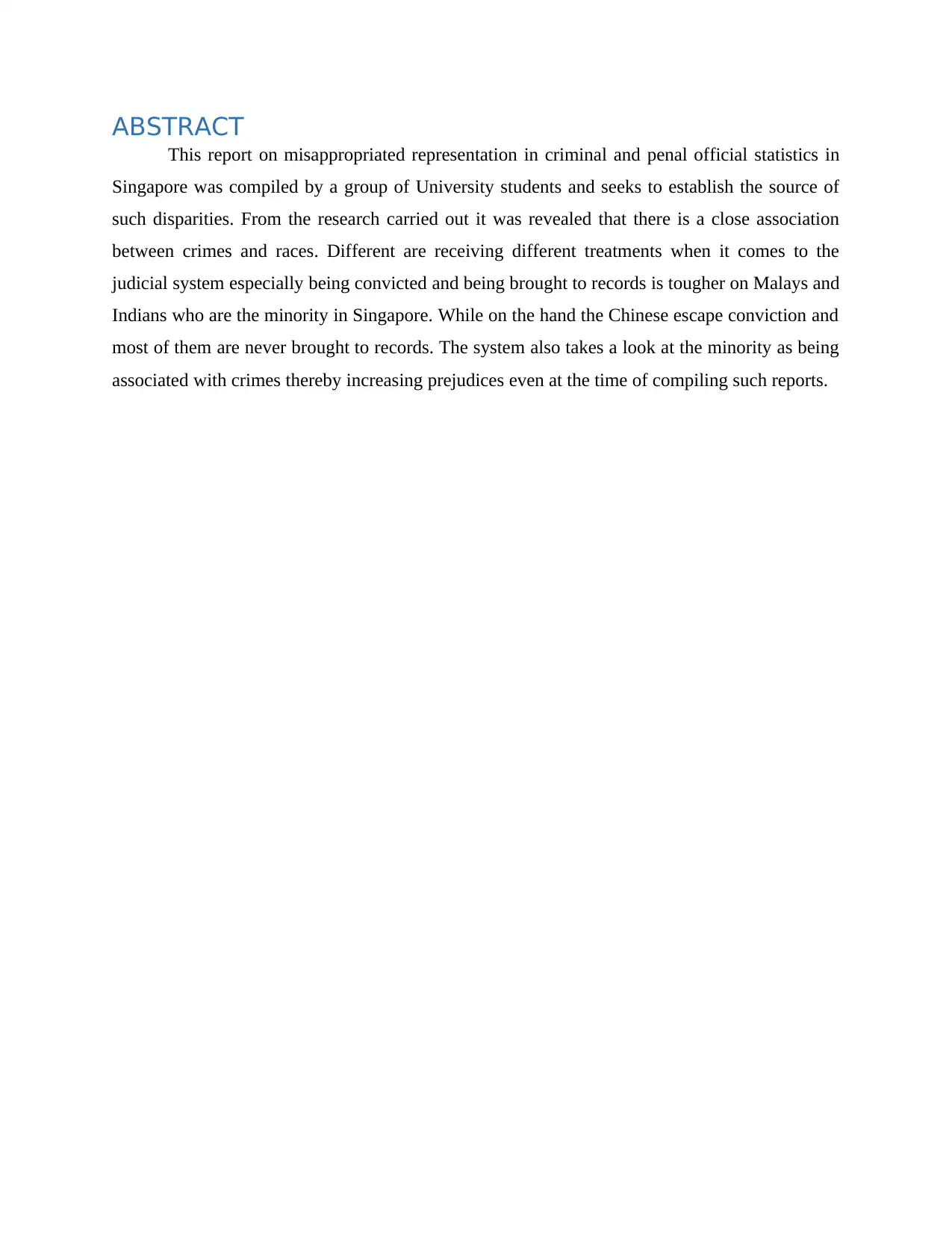
ABSTRACT
This report on misappropriated representation in criminal and penal official statistics in
Singapore was compiled by a group of University students and seeks to establish the source of
such disparities. From the research carried out it was revealed that there is a close association
between crimes and races. Different are receiving different treatments when it comes to the
judicial system especially being convicted and being brought to records is tougher on Malays and
Indians who are the minority in Singapore. While on the hand the Chinese escape conviction and
most of them are never brought to records. The system also takes a look at the minority as being
associated with crimes thereby increasing prejudices even at the time of compiling such reports.
This report on misappropriated representation in criminal and penal official statistics in
Singapore was compiled by a group of University students and seeks to establish the source of
such disparities. From the research carried out it was revealed that there is a close association
between crimes and races. Different are receiving different treatments when it comes to the
judicial system especially being convicted and being brought to records is tougher on Malays and
Indians who are the minority in Singapore. While on the hand the Chinese escape conviction and
most of them are never brought to records. The system also takes a look at the minority as being
associated with crimes thereby increasing prejudices even at the time of compiling such reports.
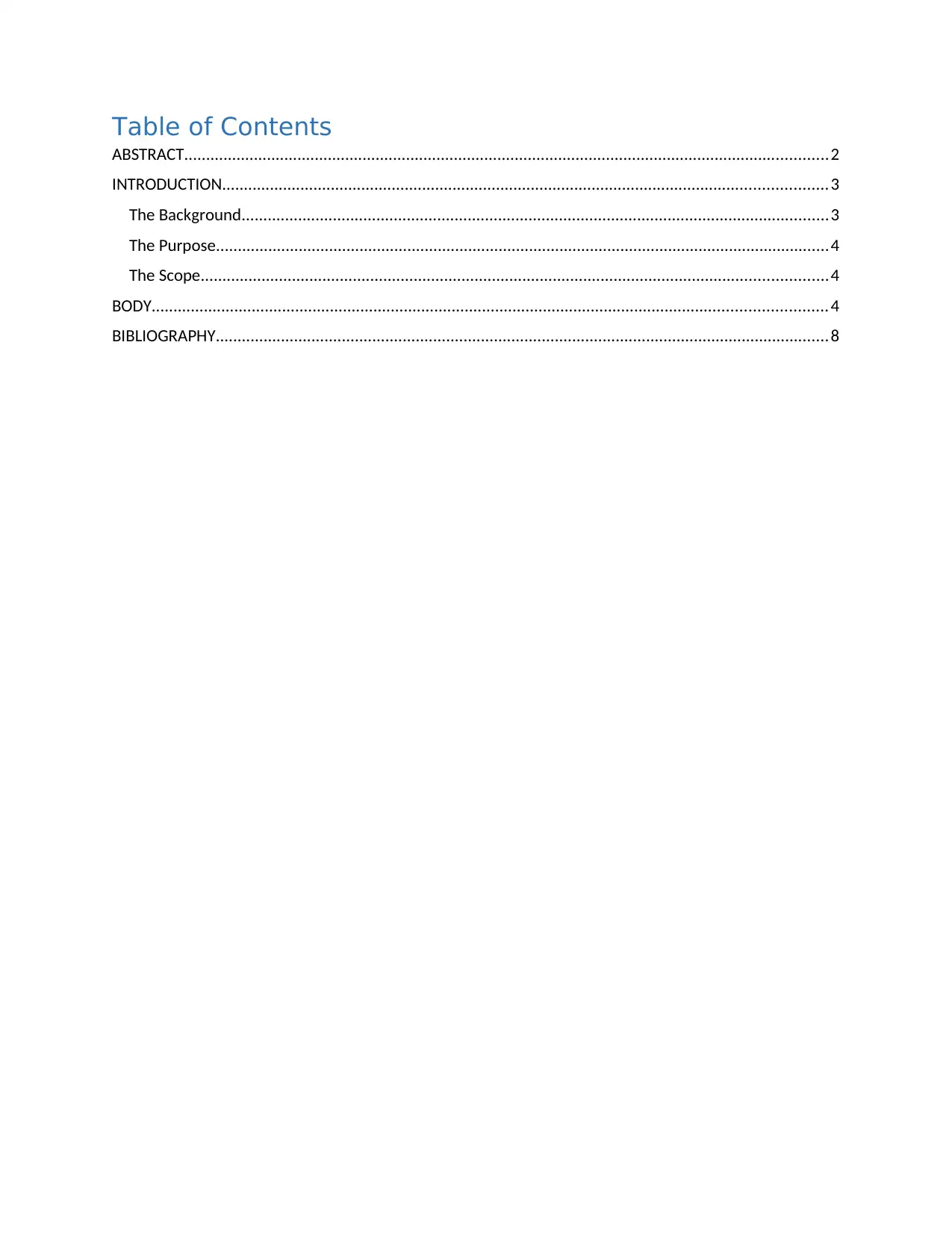
Table of Contents
ABSTRACT....................................................................................................................................................2
INTRODUCTION...........................................................................................................................................3
The Background.......................................................................................................................................3
The Purpose.............................................................................................................................................4
The Scope................................................................................................................................................4
BODY...........................................................................................................................................................4
BIBLIOGRAPHY.............................................................................................................................................8
ABSTRACT....................................................................................................................................................2
INTRODUCTION...........................................................................................................................................3
The Background.......................................................................................................................................3
The Purpose.............................................................................................................................................4
The Scope................................................................................................................................................4
BODY...........................................................................................................................................................4
BIBLIOGRAPHY.............................................................................................................................................8
⊘ This is a preview!⊘
Do you want full access?
Subscribe today to unlock all pages.

Trusted by 1+ million students worldwide
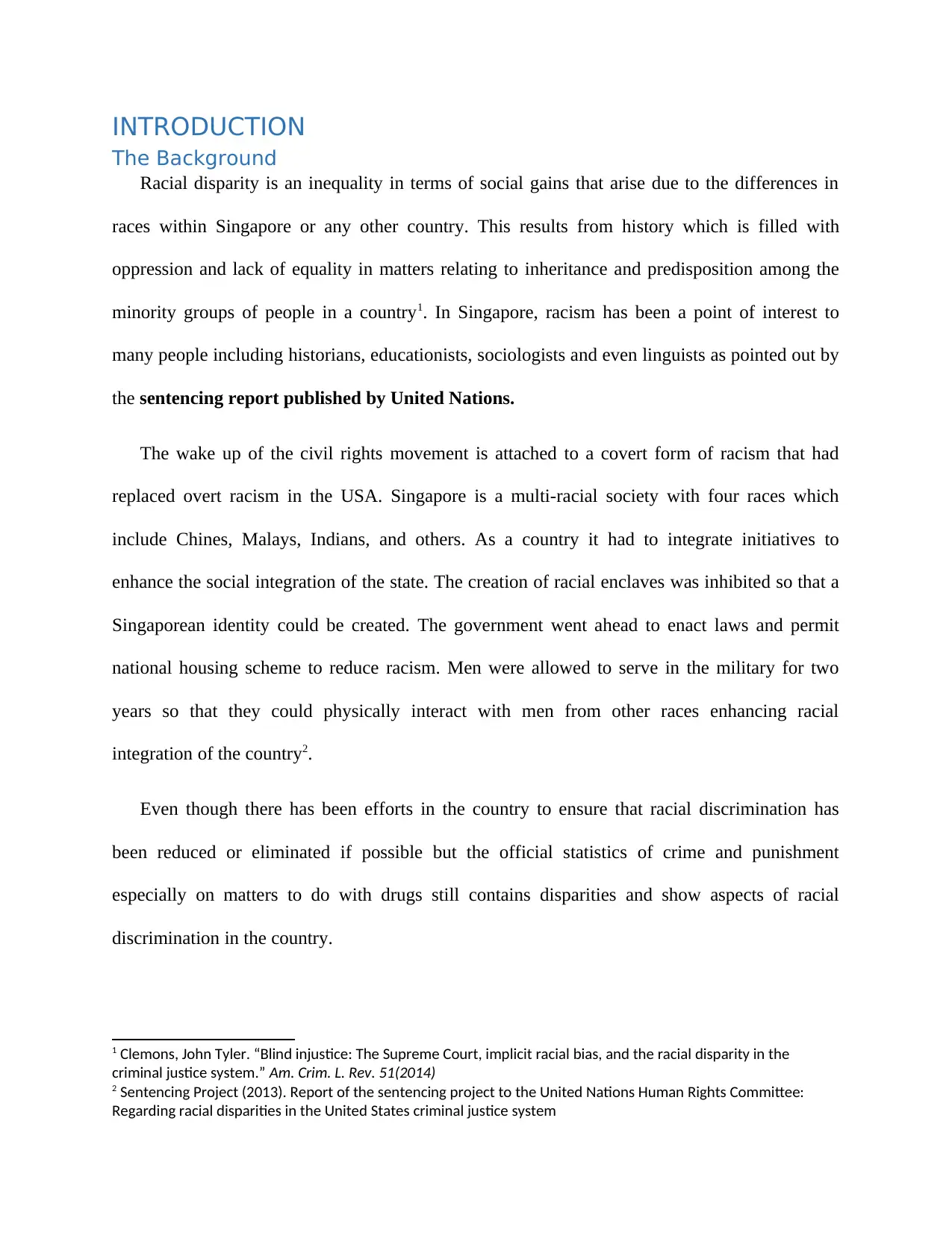
INTRODUCTION
The Background
Racial disparity is an inequality in terms of social gains that arise due to the differences in
races within Singapore or any other country. This results from history which is filled with
oppression and lack of equality in matters relating to inheritance and predisposition among the
minority groups of people in a country1. In Singapore, racism has been a point of interest to
many people including historians, educationists, sociologists and even linguists as pointed out by
the sentencing report published by United Nations.
The wake up of the civil rights movement is attached to a covert form of racism that had
replaced overt racism in the USA. Singapore is a multi-racial society with four races which
include Chines, Malays, Indians, and others. As a country it had to integrate initiatives to
enhance the social integration of the state. The creation of racial enclaves was inhibited so that a
Singaporean identity could be created. The government went ahead to enact laws and permit
national housing scheme to reduce racism. Men were allowed to serve in the military for two
years so that they could physically interact with men from other races enhancing racial
integration of the country2.
Even though there has been efforts in the country to ensure that racial discrimination has
been reduced or eliminated if possible but the official statistics of crime and punishment
especially on matters to do with drugs still contains disparities and show aspects of racial
discrimination in the country.
1 Clemons, John Tyler. “Blind injustice: The Supreme Court, implicit racial bias, and the racial disparity in the
criminal justice system.” Am. Crim. L. Rev. 51(2014)
2 Sentencing Project (2013). Report of the sentencing project to the United Nations Human Rights Committee:
Regarding racial disparities in the United States criminal justice system
The Background
Racial disparity is an inequality in terms of social gains that arise due to the differences in
races within Singapore or any other country. This results from history which is filled with
oppression and lack of equality in matters relating to inheritance and predisposition among the
minority groups of people in a country1. In Singapore, racism has been a point of interest to
many people including historians, educationists, sociologists and even linguists as pointed out by
the sentencing report published by United Nations.
The wake up of the civil rights movement is attached to a covert form of racism that had
replaced overt racism in the USA. Singapore is a multi-racial society with four races which
include Chines, Malays, Indians, and others. As a country it had to integrate initiatives to
enhance the social integration of the state. The creation of racial enclaves was inhibited so that a
Singaporean identity could be created. The government went ahead to enact laws and permit
national housing scheme to reduce racism. Men were allowed to serve in the military for two
years so that they could physically interact with men from other races enhancing racial
integration of the country2.
Even though there has been efforts in the country to ensure that racial discrimination has
been reduced or eliminated if possible but the official statistics of crime and punishment
especially on matters to do with drugs still contains disparities and show aspects of racial
discrimination in the country.
1 Clemons, John Tyler. “Blind injustice: The Supreme Court, implicit racial bias, and the racial disparity in the
criminal justice system.” Am. Crim. L. Rev. 51(2014)
2 Sentencing Project (2013). Report of the sentencing project to the United Nations Human Rights Committee:
Regarding racial disparities in the United States criminal justice system
Paraphrase This Document
Need a fresh take? Get an instant paraphrase of this document with our AI Paraphraser
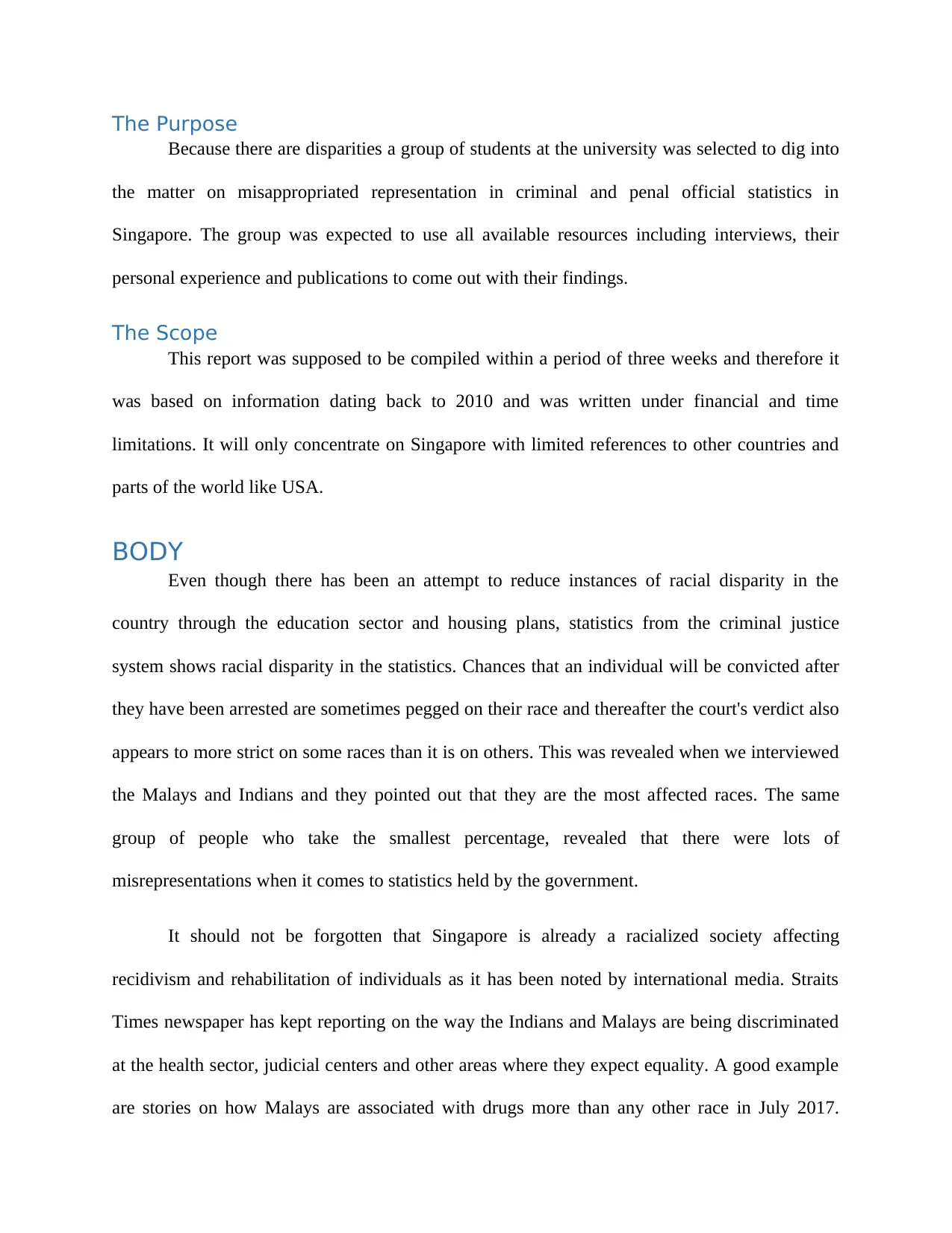
The Purpose
Because there are disparities a group of students at the university was selected to dig into
the matter on misappropriated representation in criminal and penal official statistics in
Singapore. The group was expected to use all available resources including interviews, their
personal experience and publications to come out with their findings.
The Scope
This report was supposed to be compiled within a period of three weeks and therefore it
was based on information dating back to 2010 and was written under financial and time
limitations. It will only concentrate on Singapore with limited references to other countries and
parts of the world like USA.
BODY
Even though there has been an attempt to reduce instances of racial disparity in the
country through the education sector and housing plans, statistics from the criminal justice
system shows racial disparity in the statistics. Chances that an individual will be convicted after
they have been arrested are sometimes pegged on their race and thereafter the court's verdict also
appears to more strict on some races than it is on others. This was revealed when we interviewed
the Malays and Indians and they pointed out that they are the most affected races. The same
group of people who take the smallest percentage, revealed that there were lots of
misrepresentations when it comes to statistics held by the government.
It should not be forgotten that Singapore is already a racialized society affecting
recidivism and rehabilitation of individuals as it has been noted by international media. Straits
Times newspaper has kept reporting on the way the Indians and Malays are being discriminated
at the health sector, judicial centers and other areas where they expect equality. A good example
are stories on how Malays are associated with drugs more than any other race in July 2017.
Because there are disparities a group of students at the university was selected to dig into
the matter on misappropriated representation in criminal and penal official statistics in
Singapore. The group was expected to use all available resources including interviews, their
personal experience and publications to come out with their findings.
The Scope
This report was supposed to be compiled within a period of three weeks and therefore it
was based on information dating back to 2010 and was written under financial and time
limitations. It will only concentrate on Singapore with limited references to other countries and
parts of the world like USA.
BODY
Even though there has been an attempt to reduce instances of racial disparity in the
country through the education sector and housing plans, statistics from the criminal justice
system shows racial disparity in the statistics. Chances that an individual will be convicted after
they have been arrested are sometimes pegged on their race and thereafter the court's verdict also
appears to more strict on some races than it is on others. This was revealed when we interviewed
the Malays and Indians and they pointed out that they are the most affected races. The same
group of people who take the smallest percentage, revealed that there were lots of
misrepresentations when it comes to statistics held by the government.
It should not be forgotten that Singapore is already a racialized society affecting
recidivism and rehabilitation of individuals as it has been noted by international media. Straits
Times newspaper has kept reporting on the way the Indians and Malays are being discriminated
at the health sector, judicial centers and other areas where they expect equality. A good example
are stories on how Malays are associated with drugs more than any other race in July 2017.
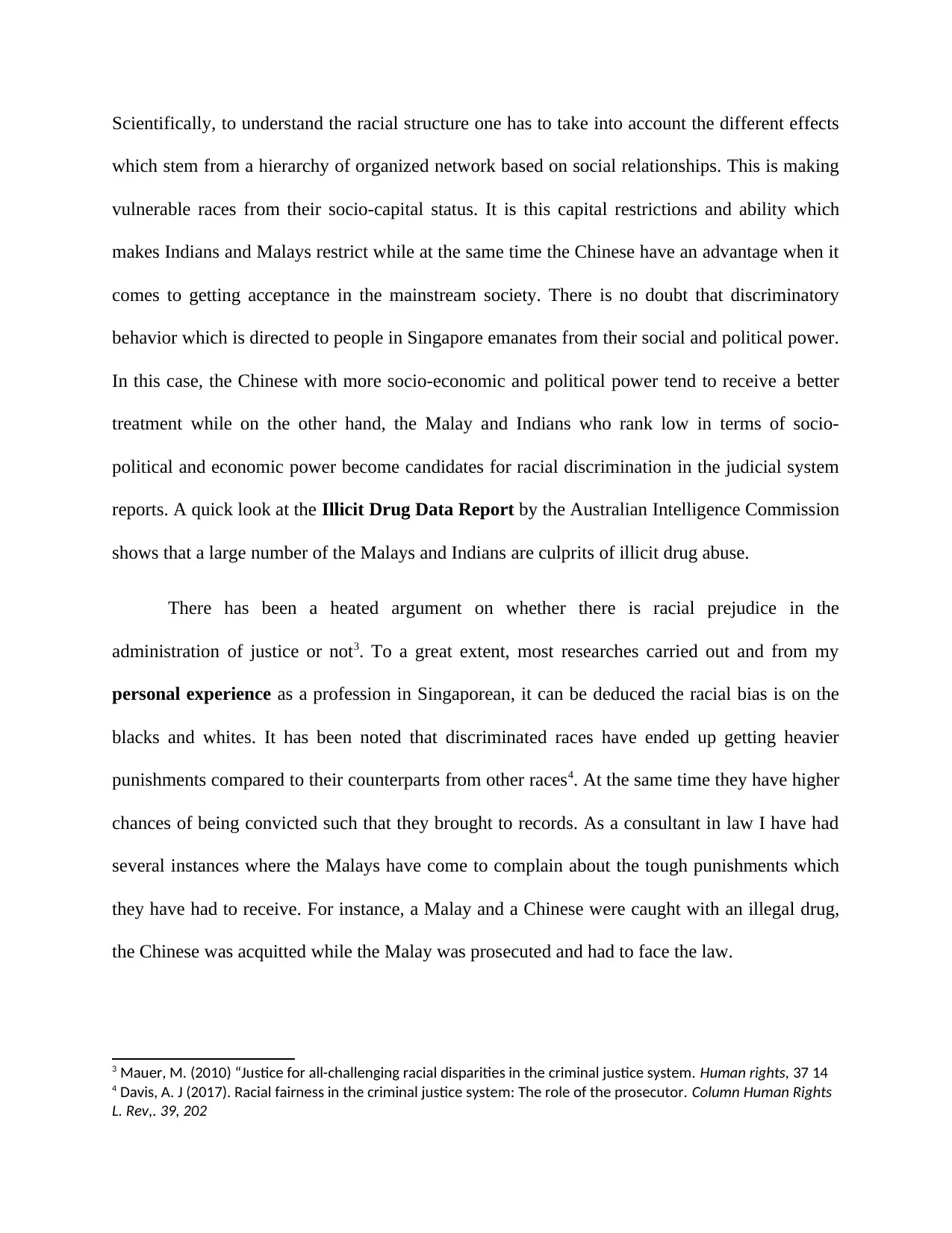
Scientifically, to understand the racial structure one has to take into account the different effects
which stem from a hierarchy of organized network based on social relationships. This is making
vulnerable races from their socio-capital status. It is this capital restrictions and ability which
makes Indians and Malays restrict while at the same time the Chinese have an advantage when it
comes to getting acceptance in the mainstream society. There is no doubt that discriminatory
behavior which is directed to people in Singapore emanates from their social and political power.
In this case, the Chinese with more socio-economic and political power tend to receive a better
treatment while on the other hand, the Malay and Indians who rank low in terms of socio-
political and economic power become candidates for racial discrimination in the judicial system
reports. A quick look at the Illicit Drug Data Report by the Australian Intelligence Commission
shows that a large number of the Malays and Indians are culprits of illicit drug abuse.
There has been a heated argument on whether there is racial prejudice in the
administration of justice or not3. To a great extent, most researches carried out and from my
personal experience as a profession in Singaporean, it can be deduced the racial bias is on the
blacks and whites. It has been noted that discriminated races have ended up getting heavier
punishments compared to their counterparts from other races4. At the same time they have higher
chances of being convicted such that they brought to records. As a consultant in law I have had
several instances where the Malays have come to complain about the tough punishments which
they have had to receive. For instance, a Malay and a Chinese were caught with an illegal drug,
the Chinese was acquitted while the Malay was prosecuted and had to face the law.
3 Mauer, M. (2010) “Justice for all-challenging racial disparities in the criminal justice system. Human rights, 37 14
4 Davis, A. J (2017). Racial fairness in the criminal justice system: The role of the prosecutor. Column Human Rights
L. Rev,. 39, 202
which stem from a hierarchy of organized network based on social relationships. This is making
vulnerable races from their socio-capital status. It is this capital restrictions and ability which
makes Indians and Malays restrict while at the same time the Chinese have an advantage when it
comes to getting acceptance in the mainstream society. There is no doubt that discriminatory
behavior which is directed to people in Singapore emanates from their social and political power.
In this case, the Chinese with more socio-economic and political power tend to receive a better
treatment while on the other hand, the Malay and Indians who rank low in terms of socio-
political and economic power become candidates for racial discrimination in the judicial system
reports. A quick look at the Illicit Drug Data Report by the Australian Intelligence Commission
shows that a large number of the Malays and Indians are culprits of illicit drug abuse.
There has been a heated argument on whether there is racial prejudice in the
administration of justice or not3. To a great extent, most researches carried out and from my
personal experience as a profession in Singaporean, it can be deduced the racial bias is on the
blacks and whites. It has been noted that discriminated races have ended up getting heavier
punishments compared to their counterparts from other races4. At the same time they have higher
chances of being convicted such that they brought to records. As a consultant in law I have had
several instances where the Malays have come to complain about the tough punishments which
they have had to receive. For instance, a Malay and a Chinese were caught with an illegal drug,
the Chinese was acquitted while the Malay was prosecuted and had to face the law.
3 Mauer, M. (2010) “Justice for all-challenging racial disparities in the criminal justice system. Human rights, 37 14
4 Davis, A. J (2017). Racial fairness in the criminal justice system: The role of the prosecutor. Column Human Rights
L. Rev,. 39, 202
⊘ This is a preview!⊘
Do you want full access?
Subscribe today to unlock all pages.

Trusted by 1+ million students worldwide
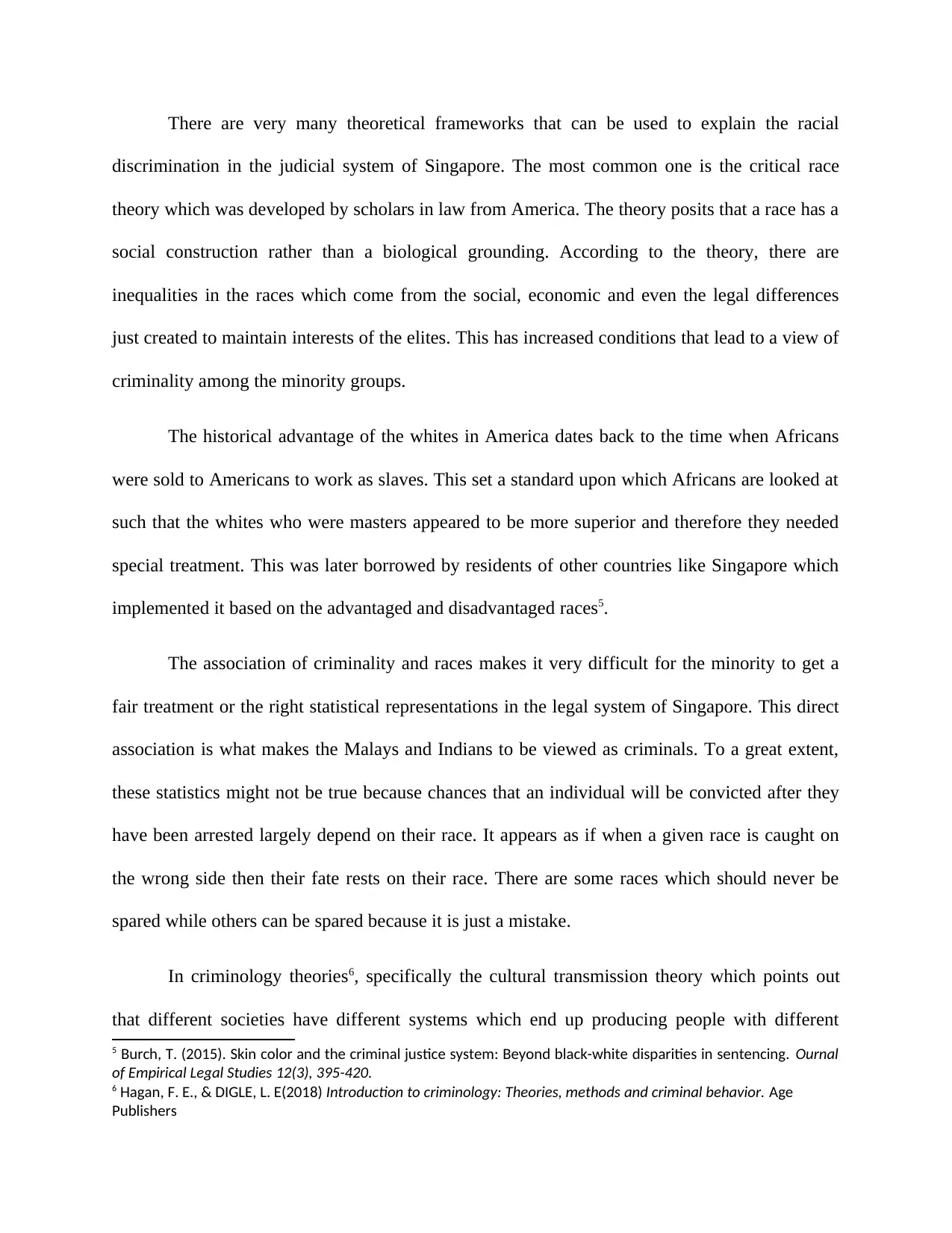
There are very many theoretical frameworks that can be used to explain the racial
discrimination in the judicial system of Singapore. The most common one is the critical race
theory which was developed by scholars in law from America. The theory posits that a race has a
social construction rather than a biological grounding. According to the theory, there are
inequalities in the races which come from the social, economic and even the legal differences
just created to maintain interests of the elites. This has increased conditions that lead to a view of
criminality among the minority groups.
The historical advantage of the whites in America dates back to the time when Africans
were sold to Americans to work as slaves. This set a standard upon which Africans are looked at
such that the whites who were masters appeared to be more superior and therefore they needed
special treatment. This was later borrowed by residents of other countries like Singapore which
implemented it based on the advantaged and disadvantaged races5.
The association of criminality and races makes it very difficult for the minority to get a
fair treatment or the right statistical representations in the legal system of Singapore. This direct
association is what makes the Malays and Indians to be viewed as criminals. To a great extent,
these statistics might not be true because chances that an individual will be convicted after they
have been arrested largely depend on their race. It appears as if when a given race is caught on
the wrong side then their fate rests on their race. There are some races which should never be
spared while others can be spared because it is just a mistake.
In criminology theories6, specifically the cultural transmission theory which points out
that different societies have different systems which end up producing people with different
5 Burch, T. (2015). Skin color and the criminal justice system: Beyond black-white disparities in sentencing. Ournal
of Empirical Legal Studies 12(3), 395-420.
6 Hagan, F. E., & DIGLE, L. E(2018) Introduction to criminology: Theories, methods and criminal behavior. Age
Publishers
discrimination in the judicial system of Singapore. The most common one is the critical race
theory which was developed by scholars in law from America. The theory posits that a race has a
social construction rather than a biological grounding. According to the theory, there are
inequalities in the races which come from the social, economic and even the legal differences
just created to maintain interests of the elites. This has increased conditions that lead to a view of
criminality among the minority groups.
The historical advantage of the whites in America dates back to the time when Africans
were sold to Americans to work as slaves. This set a standard upon which Africans are looked at
such that the whites who were masters appeared to be more superior and therefore they needed
special treatment. This was later borrowed by residents of other countries like Singapore which
implemented it based on the advantaged and disadvantaged races5.
The association of criminality and races makes it very difficult for the minority to get a
fair treatment or the right statistical representations in the legal system of Singapore. This direct
association is what makes the Malays and Indians to be viewed as criminals. To a great extent,
these statistics might not be true because chances that an individual will be convicted after they
have been arrested largely depend on their race. It appears as if when a given race is caught on
the wrong side then their fate rests on their race. There are some races which should never be
spared while others can be spared because it is just a mistake.
In criminology theories6, specifically the cultural transmission theory which points out
that different societies have different systems which end up producing people with different
5 Burch, T. (2015). Skin color and the criminal justice system: Beyond black-white disparities in sentencing. Ournal
of Empirical Legal Studies 12(3), 395-420.
6 Hagan, F. E., & DIGLE, L. E(2018) Introduction to criminology: Theories, methods and criminal behavior. Age
Publishers
Paraphrase This Document
Need a fresh take? Get an instant paraphrase of this document with our AI Paraphraser
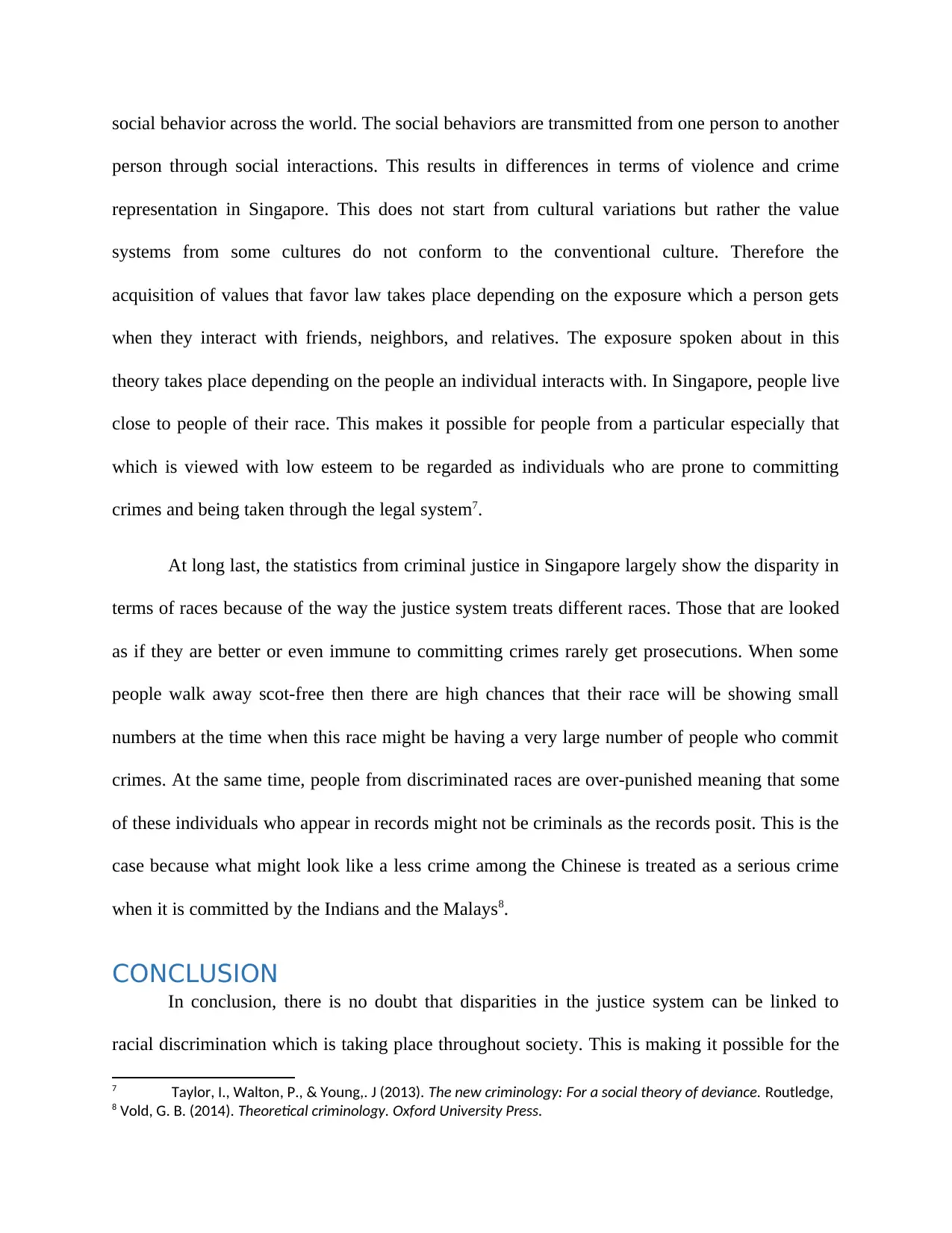
social behavior across the world. The social behaviors are transmitted from one person to another
person through social interactions. This results in differences in terms of violence and crime
representation in Singapore. This does not start from cultural variations but rather the value
systems from some cultures do not conform to the conventional culture. Therefore the
acquisition of values that favor law takes place depending on the exposure which a person gets
when they interact with friends, neighbors, and relatives. The exposure spoken about in this
theory takes place depending on the people an individual interacts with. In Singapore, people live
close to people of their race. This makes it possible for people from a particular especially that
which is viewed with low esteem to be regarded as individuals who are prone to committing
crimes and being taken through the legal system7.
At long last, the statistics from criminal justice in Singapore largely show the disparity in
terms of races because of the way the justice system treats different races. Those that are looked
as if they are better or even immune to committing crimes rarely get prosecutions. When some
people walk away scot-free then there are high chances that their race will be showing small
numbers at the time when this race might be having a very large number of people who commit
crimes. At the same time, people from discriminated races are over-punished meaning that some
of these individuals who appear in records might not be criminals as the records posit. This is the
case because what might look like a less crime among the Chinese is treated as a serious crime
when it is committed by the Indians and the Malays8.
CONCLUSION
In conclusion, there is no doubt that disparities in the justice system can be linked to
racial discrimination which is taking place throughout society. This is making it possible for the
7 Taylor, I., Walton, P., & Young,. J (2013). The new criminology: For a social theory of deviance. Routledge,
8 Vold, G. B. (2014). Theoretical criminology. Oxford University Press.
person through social interactions. This results in differences in terms of violence and crime
representation in Singapore. This does not start from cultural variations but rather the value
systems from some cultures do not conform to the conventional culture. Therefore the
acquisition of values that favor law takes place depending on the exposure which a person gets
when they interact with friends, neighbors, and relatives. The exposure spoken about in this
theory takes place depending on the people an individual interacts with. In Singapore, people live
close to people of their race. This makes it possible for people from a particular especially that
which is viewed with low esteem to be regarded as individuals who are prone to committing
crimes and being taken through the legal system7.
At long last, the statistics from criminal justice in Singapore largely show the disparity in
terms of races because of the way the justice system treats different races. Those that are looked
as if they are better or even immune to committing crimes rarely get prosecutions. When some
people walk away scot-free then there are high chances that their race will be showing small
numbers at the time when this race might be having a very large number of people who commit
crimes. At the same time, people from discriminated races are over-punished meaning that some
of these individuals who appear in records might not be criminals as the records posit. This is the
case because what might look like a less crime among the Chinese is treated as a serious crime
when it is committed by the Indians and the Malays8.
CONCLUSION
In conclusion, there is no doubt that disparities in the justice system can be linked to
racial discrimination which is taking place throughout society. This is making it possible for the
7 Taylor, I., Walton, P., & Young,. J (2013). The new criminology: For a social theory of deviance. Routledge,
8 Vold, G. B. (2014). Theoretical criminology. Oxford University Press.
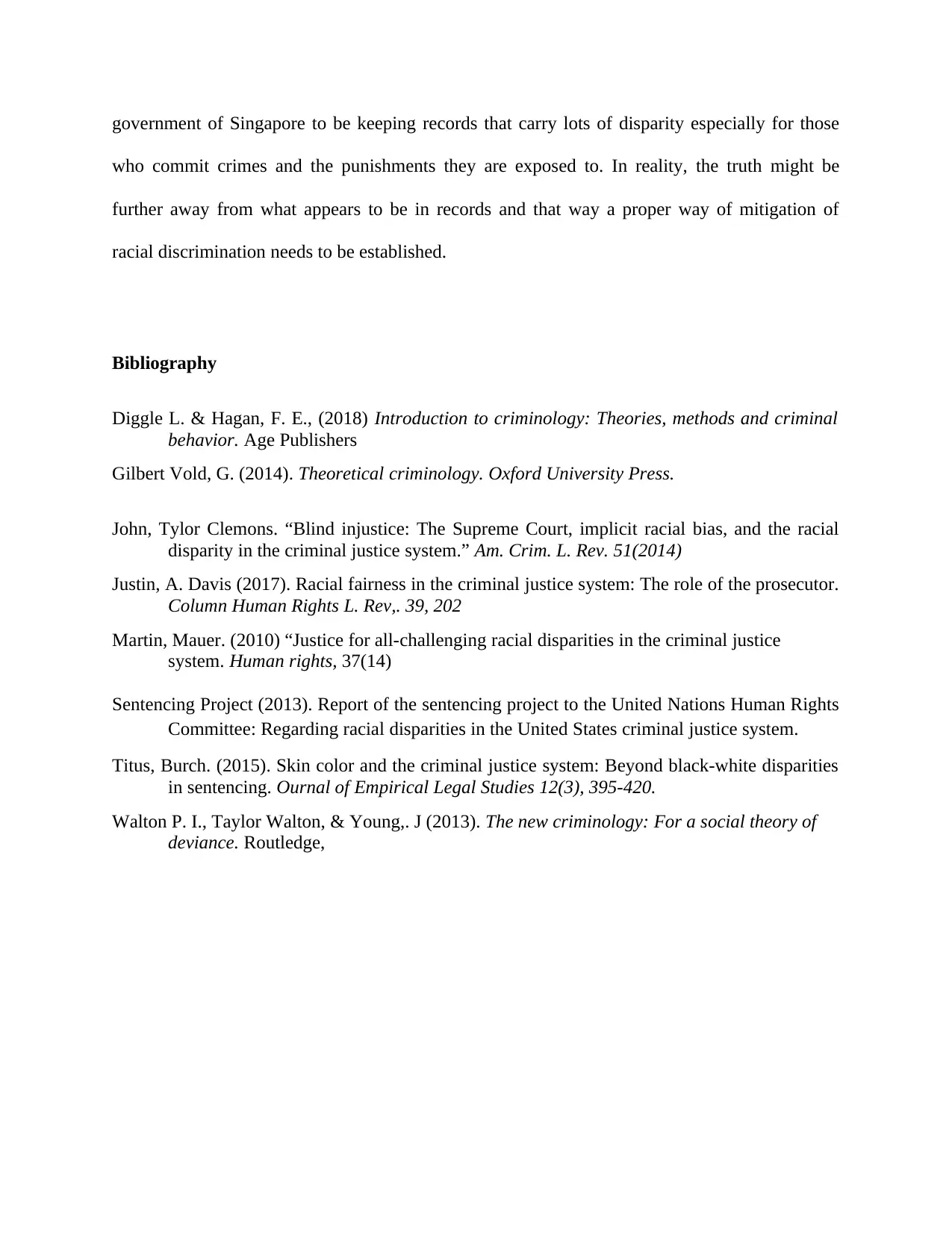
government of Singapore to be keeping records that carry lots of disparity especially for those
who commit crimes and the punishments they are exposed to. In reality, the truth might be
further away from what appears to be in records and that way a proper way of mitigation of
racial discrimination needs to be established.
Bibliography
Diggle L. & Hagan, F. E., (2018) Introduction to criminology: Theories, methods and criminal
behavior. Age Publishers
Gilbert Vold, G. (2014). Theoretical criminology. Oxford University Press.
John, Tylor Clemons. “Blind injustice: The Supreme Court, implicit racial bias, and the racial
disparity in the criminal justice system.” Am. Crim. L. Rev. 51(2014)
Justin, A. Davis (2017). Racial fairness in the criminal justice system: The role of the prosecutor.
Column Human Rights L. Rev,. 39, 202
Martin, Mauer. (2010) “Justice for all-challenging racial disparities in the criminal justice
system. Human rights, 37(14)
Sentencing Project (2013). Report of the sentencing project to the United Nations Human Rights
Committee: Regarding racial disparities in the United States criminal justice system.
Titus, Burch. (2015). Skin color and the criminal justice system: Beyond black-white disparities
in sentencing. Ournal of Empirical Legal Studies 12(3), 395-420.
Walton P. I., Taylor Walton, & Young,. J (2013). The new criminology: For a social theory of
deviance. Routledge,
who commit crimes and the punishments they are exposed to. In reality, the truth might be
further away from what appears to be in records and that way a proper way of mitigation of
racial discrimination needs to be established.
Bibliography
Diggle L. & Hagan, F. E., (2018) Introduction to criminology: Theories, methods and criminal
behavior. Age Publishers
Gilbert Vold, G. (2014). Theoretical criminology. Oxford University Press.
John, Tylor Clemons. “Blind injustice: The Supreme Court, implicit racial bias, and the racial
disparity in the criminal justice system.” Am. Crim. L. Rev. 51(2014)
Justin, A. Davis (2017). Racial fairness in the criminal justice system: The role of the prosecutor.
Column Human Rights L. Rev,. 39, 202
Martin, Mauer. (2010) “Justice for all-challenging racial disparities in the criminal justice
system. Human rights, 37(14)
Sentencing Project (2013). Report of the sentencing project to the United Nations Human Rights
Committee: Regarding racial disparities in the United States criminal justice system.
Titus, Burch. (2015). Skin color and the criminal justice system: Beyond black-white disparities
in sentencing. Ournal of Empirical Legal Studies 12(3), 395-420.
Walton P. I., Taylor Walton, & Young,. J (2013). The new criminology: For a social theory of
deviance. Routledge,
⊘ This is a preview!⊘
Do you want full access?
Subscribe today to unlock all pages.

Trusted by 1+ million students worldwide
1 out of 9
Your All-in-One AI-Powered Toolkit for Academic Success.
+13062052269
info@desklib.com
Available 24*7 on WhatsApp / Email
![[object Object]](/_next/static/media/star-bottom.7253800d.svg)
Unlock your academic potential
Copyright © 2020–2025 A2Z Services. All Rights Reserved. Developed and managed by ZUCOL.
